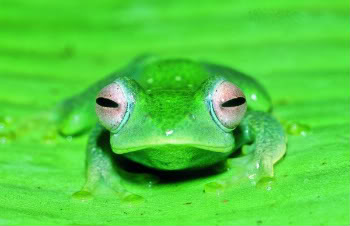|
|
Amid the amphibian extinction crisis—where amphibians worldwide are disappearing due to habitat loss, pollution, and a devastating fungal epidemic—the Spanish Scientific Research Council (CSIC) has announced some good news. In a survey of the island-nation of Madagascar they have identified between 129 and 221 new species of frogs. The discovery of so many new species nearly doubles the island’s total number of frogs.
“During the past 15 years, we discovered and described over 100 new frog species from Madagascar, which led us to believe that our species inventory is almost complete. But as our new surveys show, there are many more species than we suspected,” said Dr. Frank Glaw, curator of herpetology at the Zoologische Staatssammlung in Munich.
 New frog species from Madagascar, Boophis aff elenae. Photo by: Miguel Vences |
The survey’s findings, published in the Proceedings of the National Academy of Sciences, have led researchers to wonder how many undiscovered species still remain in Madagascar—and worldwide.
“People think that we know which plant and animal species live on this planet. But the century of discoveries has only just begun – the majority of life forms on Earth is still awaiting scientific recognition,” said Dr. Miguel Vences, professor at the Technical University of Braunschweig.
The discovery of so many species, including nearly a quarter of which have not been found in any of Madagascar’s protected areas, raises conservation alarm bells. Having already lost nearly 80 percent of its original forest cover, Madagascar is currently experiencing an environmental crisis due to political instability.
In mid-March Andry Rajoelina seized power from former president Marc Ravalomanana, creating a political vacuum that has led to armed gangs entering Madagascar’s remaining forests for rosewood. Paid by Chinese timber traders these gangs have been reported logging forests in Madagascar’s National Parks, threatening habitat for thousands of species including the newly discovered frogs.
“Although a lot of reserves and national parks have been created in Madagascar during the last decade, the actual situation of politic instability is allowing the cut of the forest within national parks, generating a lot of uncertainty about the future of the planned network of protected areas,” says David R. Vieities with the CSIC.
Related articles
Smallest Andean frog discovered in cloud forests of Peru
(03/18/2009) At 3,000 meters (9,842 feet) in the Andes herpetologists were surprised to discover a frog so small it could sit on a dime with room to spare. Further study showed that this new species, named Noble’s pygmy frog, is the smallest frog in the Andean mountain range.
Frogs can be used to predict biodiversity hotspots
(02/05/2009) Tree frogs may help scientists inexpensively predict biodiversity hotspots for conservation, report researchers writing in the journal Science.
Photos of new frogs discovered in Colombia
(02/03/2009) Ten undescribed species of amphibians — including nine frog and one salamander — have been discovered in the mountains of Colombia, report scientists from Conservation International (CI). The “new” amphibians included spiky-skinned, orange-legged rain frog, three poison dart frogs and three glass frogs, named for their transparent skin. The amphibians were discovered during a recent Rapid Assessment Program (RAP) expedition in the Tacarcuna area of the Darien, near the border with Panama.